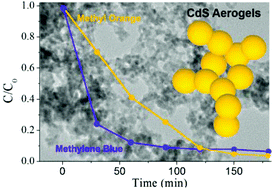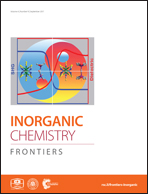CdS aerogels as efficient photocatalysts for degradation of organic dyes under visible light irradiation†
Abstract
Synthesis of efficient photocatalysts based on CdS nanomaterials for oxidative decomposition of organic effluents typically focuses on (a) enhancement of surface area of the catalysts and (b) promotion of the separation of photogenerated electron–hole pairs. CdS aerogel, which are synthesized by simple sol–gel assembly of discrete nanocrystals (NCs) into a porous network followed by supercritical drying, could provide higher surface area for photocatalytic reactions along with facile charge separation due to direct contact between NCs via covalent bonding. We evaluated the efficiency of CdS aerogel materials for degradation of organic dyes using methylene blue (MB) and methyl orange (MO) as test cases. CdS aerogel materials exhibited remarkable photocatalytic activity for dye degradation compared to typical, ligand-capped CdS NCs. The catalytic efficiency of CdS aerogels was further improved by decreasing the chain-length and extent of surface organics, leading to higher, and more hydrophilic, accessible surface area. The use of porous, chalcogenide-based solid state architectures for photocatalysis enables easy separation of catalyst while ensuring a high-interfacial surface area for analyte reactivity and visible light activation.

- This article is part of the themed collection: In honour of Mercouri G. Kanatzidis for his contributions to Inorganic Chemistry for over 30 years


 Please wait while we load your content...
Please wait while we load your content...